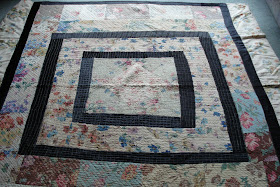Here is a quilt made in about 1900-1910. It is made from furnishing offcuts in Linen Union (i.e. a cotton linen mix). The use of black fabrics in quilts is quite common in quilts of this date, and there do seem to be a lot of this particular pattern about. Black was evidently a fashionable colour at that time.

The fabrics are various floral furnishing fabrics, giving a cheerful appearance. It is quite a heavy quilt - and large, about 76 inches square.

The centre is a diamond in a square pattern. The whole is machine quilted in white thread.

The reverse of the quilt shows a similar pattern.

We can tell that this is the reverse as the quilting follows the front side of the quilt!

In one spot there is a tear, and we can see that the filling is a piece of light coloured woollen fabric (not an old blanket).

Some of the black fabric is ribbed - similar to the white dimity seen in other quilts - was dimity made in black? Dimity was used for womens' and childrens' clothes, also underclothes. Perhaps black was used for mourning clothes? or perhaps it was a practical colour to hide any smudges....

As is common with these scrap quilts, bolt ends have been used, and one can see lettering still remaining.

Another look at the floral fabrics used in this quilt. Originally bought at an auction house in Watlington - Jones & Jacob.
 The fabrics are various floral furnishing fabrics, giving a cheerful appearance. It is quite a heavy quilt - and large, about 76 inches square.
The fabrics are various floral furnishing fabrics, giving a cheerful appearance. It is quite a heavy quilt - and large, about 76 inches square. The centre is a diamond in a square pattern. The whole is machine quilted in white thread.
The centre is a diamond in a square pattern. The whole is machine quilted in white thread.
 We can tell that this is the reverse as the quilting follows the front side of the quilt!
We can tell that this is the reverse as the quilting follows the front side of the quilt!



No comments:
Post a Comment